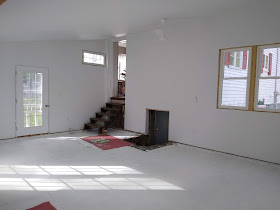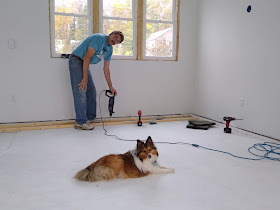Seeing as the space we are converting was a single stall garage and a mud room, it just had an average everyday old uneven cement floor. There were cracks here and there, and a big uneven divide up the middle where the two pieces of cement met when it was first poured years and years ago. Now it was up to us to get it all sealed in, leveled, and a subfloor built, ready to install new flooring on top.
We had used this product before, so we knew what we were dealing with.
First, we totally cleaned the floor and swept it well making sure it was dry before we began. Steve sealed up all of the cracks around the edges where the footing met the cement slab with a special cement urethane caulk. He went through about six tubes, but it was well worth it.
Using a heavy nap roller on a long extension handle we rolled the first coat of elastomeric paint on the floor.
We set out two big fans
to circulate the air
and assist in its drying time overnight.
to circulate the air
and assist in its drying time overnight.
The next day, the first coat was thoroughly dry, so we could add a second layer. Wow, it was amazing to see how big the room appeared once the floor was all white and bright.
(the 4x12 space by the door will be ceramic tile later)
THIS IS GETTING SOOOO EXCITING!
(to me, anyhow)
The next step was to start building a framework of cross support joists over and around the original stairs that lead down to the basement. There is another full size entrance to our basement on the other side of our house. So we really don't need these. Besides, they are old rubble stone, crumbling and dangerous! By closing them off, we can run flooring directly over the top of it. Steve had recently acquired a very nice hammer drill that took care of drilling the holes and then screwing in the special cement tapcon screws into the cement foundation.
I have a pic of the first three boards around the edges of the stairs, but didn't get a shot of the four cross board joists he put over the open space. Once that was done, he then covered the entire thing with a thick piece of sub floor to bring it up level to the rest of the floor.
This really came in handy
to find the highest spot
and the lowest spot
of the uneven flooring.
Finnegan thought he needed to get in on the ACT
In the old days, they would have scribed it (or pour all new cement that was level!) But with the lazer level, each board had to be carefully marked with a magic marker all along the laser line. That was my job. Crawling on my hands and knees I carefully marked each board with little lines, every foot or so, as to where we needed to cut it.
When each floor joist was brought back into the space and carefully screwed down into the cement --- using the hammer drill and tap con screws. We had to measure everything as exactly and carefully as we could. By spacing the support joists at 12 inch on center, it would make an even sturdier floor than the traditional 16 inch on center of most flooring installations. Less movement, less squeaks.
We did a lot of "knee work" and used foam gardening pads instead of the strap on knee pads. It seemed to work better for us. We also used a lot of ibuprofen at night.
We had to carefully allow access for the natural gas pipe to cross the room and come up in the area that we had decided to add a natural gas fireplace stove unit. We also had to accommodate electrical wiring for two different in-floor outlets. I wanted one underneath the couch and the other underneath my center sewing island. Much better than having extension cords stretched across to the walls ... and safer too.
We worked our way across the floor putting each board into place and soon we were able to move on to the next step by the next afternoon.
Now we cut layers of rigid Styrofoam on the table saw, again it was a two person process to help hold it steady as it ripped through the insulation. A long time ago, I found Steve that old Craftsman table saw at a rummage sale, for a bargain price of $50 and I snapped it up. I only had my car, but the guy at the rummage sale DELIVERED it for me! Surprise Surprise when Steve got home. I added to his "tool collection"!
Each piece was then laid into the spaces
between the joists
to add extra insulation to the floor.
(we creatively used the scraps too,
and utilized my quilting cutting skills to make them all fit)
NEXT we had to come to a fork in the road. We had to make a BIG decision on what way to go with the next step, and if you stay tuned to my next blog, you will read why. Hmmmmmmm?






















Karen
ReplyDeleteYou and Steve do great work. Would really like to have a place to build a work shop and a separate sewing room for my wife. Looks great as to what you have accomplished so far.
I enjoy your various home projects. Thanks for going into such detail!
ReplyDelete